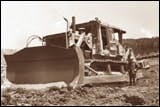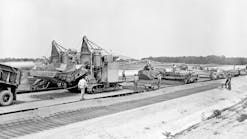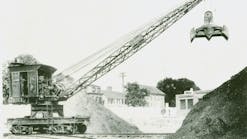Allis-Chalmers gave at-tendees a taste of things to come at the 1963 Chicago Road Show when it introduced the HD-41 crawler tractor. With a weight of 70 tons and 524 horsepower, the new crawler tractor made headlines as the largest built up to that time. It was only a preview though. Allis-Chalmers wanted to be certain the big dozer would perform exactly how it was intended — be a reliable producer and lower unit cost per cubic yard. So its brief appearance was followed by a lengthy development program with a number of prototypes field-tested in a wide variety of conditions. Customers had to wait until 1970 before it was finally put into full production.
Allis-Chalmers Manufacturing was a major force in big crawler tractors in the 1950s and early 1960s and no stranger to breaking records in the big tractor field. The industrial giant had expanded its tractor division in 1928 when it purchased Monarch Tractor Corp. of Springfield, Illinois. At first Allis-Chalmers marketed the Monarch crawler tractors as its own branded product, but soon re-engineered models began to appear as new technology became available. The 75-drawbar-horsepower Model L gasoline tractor of 1931 was one of the largest crawler tractors built at that time, tipping the scales at 11 tons.
In 1938, Allis-Chalmers started developing its diesel-powered tractor line using General Motors engines. Three models were put in production in 1940 to replace the previous oil tractors; the HD-7, HD-10 and HD-14. The largest of this trio was the most powerful crawler tractor available on the market at that time at 132 drawbar horsepower. This model was also the first crawler tractor to be offered with a torque converter when it was upgraded in 1945. Allis-Chalmers claimed the world size record again in 1947 with the 163-hp HD-19, weighing approximately 25 tons equipped with dozer blade.
The HD-41 tractor came with a Cummins VT-1710-C four-cycle turbocharged diesel and torque converter. Its power-shift transmission provided three speeds in either direction for a top forward speed of 6.5 mph. Attachments included bulldozer blades up to 20 feet wide in semi-U and full-U options and a cushioned push block for push-loading scrapers.
In 1974, Fiat S.p.A. of Italy purchased the majority of Allis-Chalmers shares, and the Fiat-Allis joint venture was born. Crawler tractors were continued as Fiat-Allis machines but the "HD" prefix was dropped. The upgraded 41-B model appeared in 1974, and further revisions brought the Fiat-Allis FD-50 with Cummins VT28-C engine in 1982.
Market conditions softened in the 1980s for Fiat-Allis, and the FD-50 was discontinued by 1989 when the company transferred all its earthmoving equipment manufacturing to Italy. The company maintained a sales and parts organization to market imported machines until it was absorbed into CNH Global in 1999.
You can read more about the evolution of construction equipment in Keith Haddock's book, "Giant Earthmovers an Illustrated History" available in most bookstores. Also, consider a membership in the Historical Construction Equipment Association, www.hcea.net.






